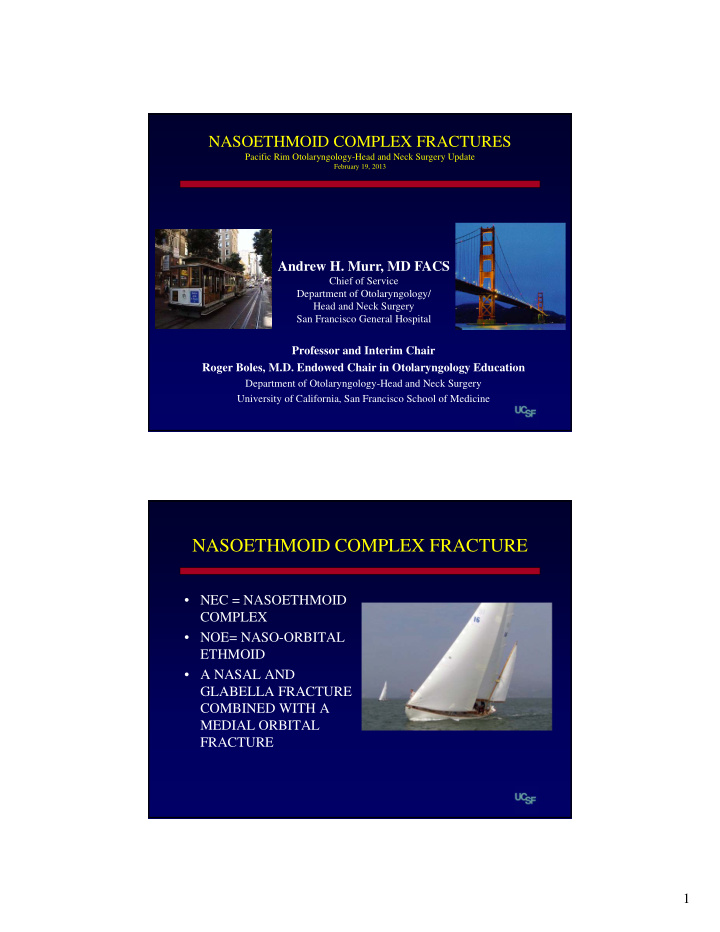



NASOETHMOID COMPLEX FRACTURES Pacific Rim Otolaryngology-Head and Neck Surgery Update February 19, 2013 Andrew H. Murr, MD FACS Chief of Service Department of Otolaryngology/ Head and Neck Surgery San Francisco General Hospital Professor and Interim Chair Roger Boles, M.D. Endowed Chair in Otolaryngology Education Department of Otolaryngology-Head and Neck Surgery University of California, San Francisco School of Medicine NASOETHMOID COMPLEX FRACTURE • NEC = NASOETHMOID COMPLEX • NOE= NASO-ORBITAL ETHMOID • A NASAL AND GLABELLA FRACTURE COMBINED WITH A MEDIAL ORBITAL FRACTURE 1
THE SINGLE GREATEST ADVANCE I’VE SEEN IN MIDFACE TRAUMA IS… ORBIT ANATOMY 2
BONES THAT COMPRISE THE ORBIT ORBIT ANATOMY 3
ANATOMY OF THE LACRIMAL SYSTEM ANATOMY: MEDIAL CANTHAL TENDON • MCT inserts on the lacrimal bone – Anterior tendon inserts on the anterior lacrimal crest – Posterior tendon inserts on the posterior lacrimal crest • Lacrimal duct lies in between and is pumped with blinking (Jones pump) 4
SHOULD THIS HEAL WELL? YES! ETIOLOGY 5
ASSESSMENT • HISTORY • PHYSICAL EXAM – RACOON’S EYES – TRAUMATIC TELECANTHUS – “BURST” LACERATION – MOBILITY OF THE NASAL SEGMENT • IMAGING! “TRAUMATIC TELECANTHUS” 6
BURST LACERATION CHARACTERISTICS • OFTEN OCCURS WITH OTHER FRACTURES – LEFORT- Anterior Open Bight Deformity • DEPRESSED NASAL ROOT • CREPITANCE • KEY ISSUE IS MEDIAL CANTHAL TENDON POSITION AND COUNTERACTING ATTACHMENT LOSS 7
IMAGING IS KEY FOR OPERATIVE PLAN • High Resolution CT Scan with Orbital Cuts • Plain films are not helpful “THE C SIGN” 8
NOE CLASSIFICATION Markowitz-Manson • TYPE 1 – Central segment • TYPE 2 – Comminuted but canthal tendons attached • TYPE 3 – Comminuted but canthal tendons free NEC CLASSIFICATION J.S. Gruss, 1993 • Naso-orbital alone • Naso-orbital + central maxilla • Naso-orbital +LeFort II/III • Naso-orbital +orbital dystopia • Naso-orbital + loss of bone 9
BINARY NOE CLASSIFICATION • A. MCT ATTACHED! • B. MCT NOT ATTACHED! OPERATIVE APPROACH • 1. BICORONAL • 2. THROUGH THE LACERATION • 3. ANTERIOR ETHMOID APPROACH – Orbital incisions – Gingival buccal sulcus incision – Mid-facial degloving approach – “Open Sky” 10
ORBITAL INCISIONS FIRST, THERE MUST BE REDUCTION… 11
ORIF: Historical Viewpoint Bicoronal/Midfacial Degloving/Open Sky BICORONAL 12
BICORONAL PLATING MCT REPAIR • Tessier – Tessier needle • Raveh – cross wiring, with vector pulling posterior, superior • Occuloplastic literature • Manson classification 13
NEW TECHNIQUE Modified from Procedure Developed by Salyer • Repair medial orbit wall (bone or mesh) • Chose desired location for fixating medial canthus • 28 gauge wires passed in desired location, one wire superior and one inferior MCT TECHNIQUE USING BICORONAL ACCESS • Wires passed from orbit side of injury thru bone or mesh into sinus cavity and then pulled out nostril • Wires then passed thru skin, 1 mm above and below medial canthus • Nasal wires twisted together then pulled in lateral orbit direction to seat twist on medial surface of new canthus position • 15 blade used to incise between wires extruding thru skin • Forcep used to dissect down to medial canthus tendon • External wires twisted together, medial canthus now secured to lateral surface of new canthus position 14
MCT POSITIONING MCT POSITIONING UNILATERAL 15
MCT POSITIONING BILATERAL MCT POSITIONING 16
MCT POST OP POSITION THROUGH LACERATION 17
ANTERIOR ETHMOID APPROACH Special Topics Bone Anchors Bone Grafts Ducic Y, Laryngoscope, 2001 Gruss JS, Annals of PS, 1986 18
CONCLUSION • Frequently considered the most difficult injury to repair • Very difficult to get adequate reduction, very difficult to over correct • No universally accepted and “fool proof” method for reducing and fixating tendons in place 19
Recommend
More recommend